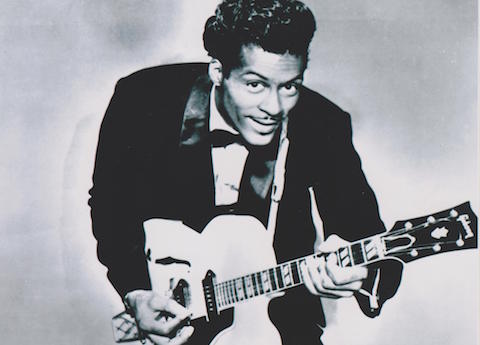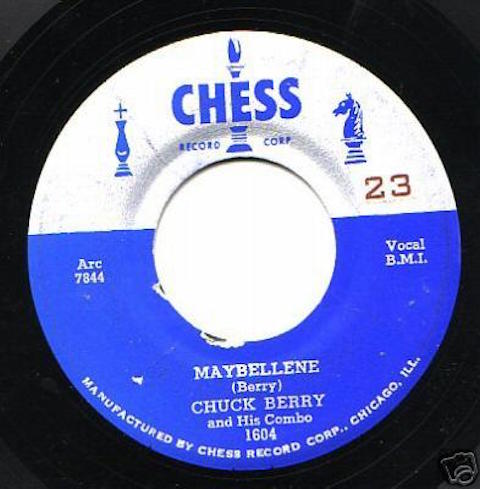 Abraham Lincoln
If given the truth, the people can be depended upon to meet any national crisis...
Abraham Lincoln
If given the truth, the people can be depended upon to meet any national crisis...
 Guildford news...
for Guildford people, brought to you by Guildford reporters - Guildford's own news service
Guildford news...
for Guildford people, brought to you by Guildford reporters - Guildford's own news service
Hearing Chuck Berry Loud And Clear On Guildford’s Cygnet Café Jukebox
Published on: 24 Mar, 2017
Updated on: 24 Mar, 2017
Dave Reading recalls hearing the music of Chuck Berry for the first time in a dark café that stood by the River Wey at Guildford. Chuck Berry died on March 18, 2017, aged 90.
The coolest place to be if you lived in Guildford in the early 1960s was the Cygnet café, which stood by the river in Millbrook.
It was a dark, dingy place frequented by beatniks and would-be beatniks. One of the attractions was the Bel Ami jukebox, which belted out obscure blues and R&B numbers by black artists such as Muddy Waters and Howlin’ Wolf.
It was there that we all got hooked on Chuck Berry. In 1962 the British charts were stagnating – dominated by over-sentimental pop tunes, many of them coated in sugary orchestral arrangements. Chuck Berry brought a longed-for excitement to the music scene – a fact recognised by the Rolling Stones, whose ground-breaking first single in early 1963 was their cover of Chuck’s Come On.

‘Ridin’ along in my automobile….’ Millmead, looking across the River Wey towards Mill Lane, St Mary’s Church and Quarry Street. Note the rather fine vehicle, likely to have been parked near the Cygnet Cafe. Picture by Eduard Eady, via Ben Darnton. Click to enlarge in a new window.
The clientele of the Cygnet – long since closed – recognised something revolutionary in Chuck Berry, but probably didn’t know the extraordinary background story of how his success had its roots not in blues, but in American country music.
The story begins at the offices of the Chess record label in the Southside of Chicago. The company’s founders, Leonard and Phil Chess, were instrumental in bringing legendary names to the attention of record buyers, including Muddy Waters.
But early in 1955 Leonard Chess caused a surprise when he took a chance on a country song – he used the term “hillbilly” – which had been written by a 28-year-old unknown singer and guitarist from St Louis.
The fact that the songwriter was black was unusual in itself – black artists and hillbilly music made an uneasy combination. But Leonard Chess sensed there was something commercially viable in what he was hearing.
Back in St Louis, the author of the song had been known for throwing in country tunes when he played for primarily black audiences. Club-goers called him “the black hillbilly”, which was probably intended as an insult, but after a while they began to request his country numbers.
The song recorded at the Chess studio in May 1955 became one of the most influential rock ‘n’ roll numbers of all time. The track was called Ida May – renamed as Maybellene – and the author and singer was, of course, Chuck Berry.
Maybellene was a pure example of how black and white music were merging to form the new rock ’n’ roll. Strangely enough, there were people who heard Chuck singing Maybellene on the radio and thought he might be a white country singer. His diction was clearer than you’d hear from most black singers and the lyrics and the beat were pure country.
Keith Richards wrote in his autobiography: “I didn’t know Chuck Berry was black for two years after I heard his music….And for ages I didn’t know Jerry Lee Lewis was white.”
In his own autobiography, Chuck wrote: “Maybellene was written from the inspiration that grew out of the country song, Ida Red. I’d heard it sung long before when I was a teenager and thought it was rhythmic and amusing to hear. I’d sung it in the yard gatherings and parties around home when I was first learning to strum the guitar in my high school days. Later in life, at the Cosmo Club, I added my bit to the song and still enjoyed a good response so I coined it a good one to sing.”
He said Maybellene was composed of high school memories and trying to get girls to ride in his 1934 V-8 Ford. He even put seat covers in it to accommodate them.
He wrote: “I have never, in my life, met or even known of any woman named Maybellene. The name actually was first brought to my knowledge from a storybook, when I was in the third grade, of animals who bore names. Along with Tom the cat and Donald the duck, there was Maybellene the cow.”
As rock ‘n’ roll took off, Chuck Berry’s career took off with it. Musical and racial boundaries were breaking down. In the mid-1950s large numbers of American adults believed their young citizens were facing a moral catastrophe.
People already had the Commie menace to fret about, and now there was this new cultural phenomenon: something they perceived to be a campaign of subversion. The peril (so they maintained) came not just from black singers but also white performers like Elvis Presley, who sounded black and therefore posed a more insidious threat.
While parents were resisting, teenagers were listening to rock ‘n’ roll on the radios late at night. Many stations refused to play the new music, but teenagers would search the radio band for the few that did. Shock horror! Rock and roll was providing a vehicle by which blacks could compete with whites and accumulate wealth!
An important social teaching during that time was that blacks were inferior to whites and it was wrong for whites to associate with blacks. Along came rock and roll and turned that upside down. White teenagers were flocking to see rock ‘n’ roll performers and prominent among them was Chuck Berry.
His influence extends throughout the world of rock music. Significantly he inspired the songwriting of Brian Wilson (I Get Around), Bob Dylan (Subterranean Homesick Blues) and John Lennon (Come Together, which even borrowed a Chuck Berry line).
Between 1957 and 1966 the Beatles performed more songs written by Chuck Berry than any other artist. He was indeed one of the handful of 20th century musicians who transformed western culture.
Responses to Hearing Chuck Berry Loud And Clear On Guildford’s Cygnet Café Jukebox
Leave a Comment Cancel replyPlease see our comments policy. All comments are moderated and may take time to appear.
Recent Articles
- Guildford Institute’s Crowdfunding Project for Accessible Toilet in its New Community and Wellbeing Centre
- Letter: Guildford – Another Opportunity Missed?
- Letter: GBC’s Corporate Strategy – Where Is the Ambition?
- My Memories of John Mayall at a Ground-breaking Gig in Guildford Nearly Six Decades Ago
- Westborough HMO Plans ‘Losing the Heart of the Street’ Says Resident
- College Invests to Boost Surrey’s Economy and Close Digital Skills Gap
- Community Lottery Brings Big Wins for Local Charities
- GBC Housing Plan Promises ‘A Vibrant Urban Neighbourhood’ Near Town Centre
- Hospital Pillows ‘Shortage’ at the Royal Surrey
- Updated: Caravans Set Up Camp at Ash Manor School


Recent Comments
- Ian Macpherson on Updated: Main Guildford to Godalming Road Closed Until August 1
- Sara Tokunaga on GBC Housing Plan Promises ‘A Vibrant Urban Neighbourhood’ Near Town Centre
- Michael Courtnage on Daily Mail Online Reports Guildford Has Highest-paid Council Officer
- Alan Judge on GBC Housing Plan Promises ‘A Vibrant Urban Neighbourhood’ Near Town Centre
- John Perkins on GBC Housing Plan Promises ‘A Vibrant Urban Neighbourhood’ Near Town Centre
- S Collins on GBC Housing Plan Promises ‘A Vibrant Urban Neighbourhood’ Near Town Centre
Search in Site
Media Gallery
Dragon Interview: Local Artist Leaves Her Mark At One of England’s Most Historic Buildings
January 21, 2023 / No Comment / Read MoreDragon Interview: Lib Dem Planning Chair: ‘Current Policy Doesn’t Work for Local People’
January 19, 2023 / No Comment / Read MoreA3 Tunnel in Guildford ‘Necessary’ for New Homes, Says Guildford’s MP
January 10, 2023 / No Comment / Read More‘Madness’ for London Road Scheme to Go Ahead Against ‘Huge Opposition’, Says SCC Leader
January 6, 2023 / No Comment / Read MoreCouncillor’s Son Starts Campaign for More Consultation on North Street Plan
December 30, 2022 / No Comment / Read MoreCounty Council Climbs Down Over London Road Works – Further ‘Engagement’ Period Announced
December 14, 2022 / No Comment / Read MoreDragon Interview: GBC Reaction to the Government’s Expected Decision to Relax Housing Targets
December 7, 2022 / No Comment / Read MoreHow Can Our Town Centre Businesses Recover? Watch the Shop Front Debate
May 18, 2020 / No Comment / Read More











John Lomas
March 24, 2017 at 11:53 pm
I know it is extraneous to the topic of Chuck Berry but for the car enthusiasts amongst us the cars in the article are a 1960 Chevrolet Impala and a Ford Thames 300E van.
The view of Millbrook fits in with the late ’60s redevelopment/ realignment.